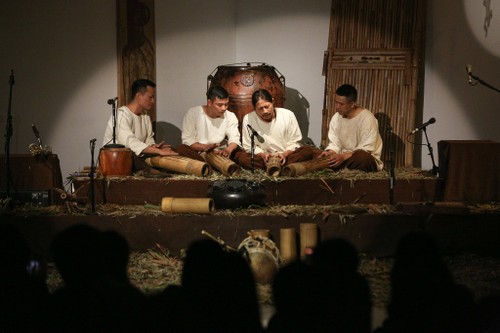 The "Dan Do" group performs using their handmade musical instruments of the same name. The "Dan Do" group performs using their handmade musical instruments of the same name. |
“Art is better felt than explained. The sound of this instrument draws us into the natural connection between humans and nature. We’re always proud to call this the ‘Dan Do’ of the Vietnamese people.”
That was musician Nguyen Duc Minh talking about the "Dan Do", the first hand-made instrument he created with his partners Dinh Anh Tuan, Tran Kim Ngoc, and Nguyen Quang Su.
"Dan Do" is one of an array of handcrafted instruments created by the Hanoi-based group over the last 12 years. The main material, bamboo, reflects the instruments' historical importance and their essential role in daily life in Vietnam, where there are over 200 different bamboo species.
“It might be simple bamboo, but adopting an artistic perspective brings out the captivating life within it. We want to give both the bamboo and the ‘Dan Do’ their own voice, personality, and soul, echoing the spirit of Vietnam and speaking the Vietnamese language,” said Minh.
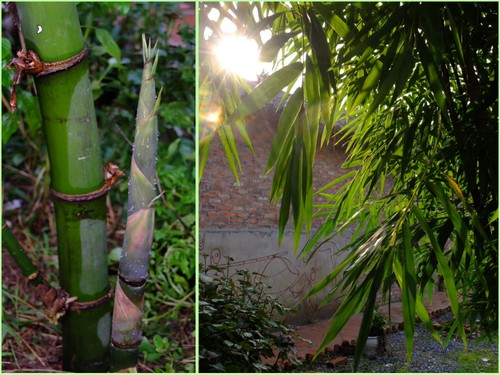 Vietnam has about 200 different bamboo species. Vietnam has about 200 different bamboo species. |
In Vietnam, bamboo has an intimate connection to both culture and daily life, from the biggest item to the smallest. For example, bamboo is used for making houses, chairs, beds, chopsticks, even toothpicks. It was even used as a weapon against foreign invaders during war, appearing in the form of bamboo poles, sticks, bows, and arrows. Bamboo also served as a protective house, offering shelter during periods of resistance.
The "Dan Do" got its name after the group saw that it looked like a traditional Vietnamese fishing tool called the “do”, used in small, slow streams to catch aquatic species. These fishing tools are made by weaving bamboo into tubular shapes that taper at one or both ends. They are secured with knots.
“In Vietnamese tradition, we prefer familiar names. "Do" is a purely Vietnamese word, closely tied to our daily life. Its simplicity perfectly fits the spirit of our group, and that’s why we’ve chosen it as both our group’s name and as the appellation of our first handmade musical instrument,” Dinh Anh Tuan elaborated.
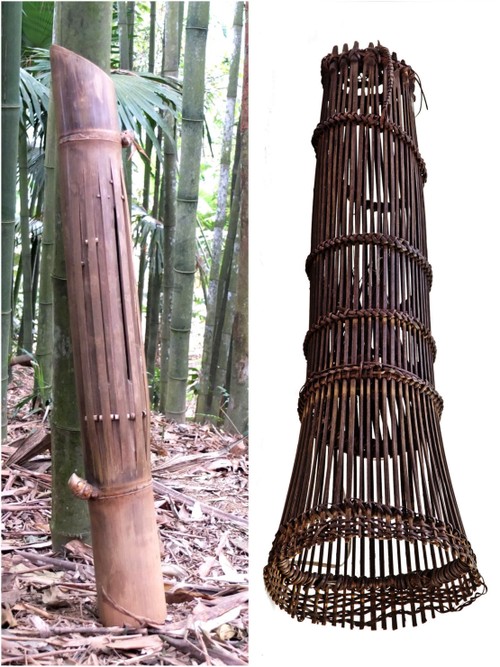 The "Dan Do" (L) looks like the “do” (R), a traditional Vietnamese fishing tool. The "Dan Do" (L) looks like the “do” (R), a traditional Vietnamese fishing tool. |
This instrument is a bamboo tube sliced vertically to create 5 “strings”. During a performance, the artist taps the strings with their fingertips, producing a metallic resonance.
Shaping the final look of the "Dan Do" was a creative journey filled with ups and downs. The group spent two years researching and experimenting, starting by finding the best bamboo species and even the best internode, very often the forth from the ground, to create the finest sound.
“We tested dozens of bamboo types to find a sound that spans from the clang of a bell to the resonance of a cymbal. The bamboo used for crafting the instrument must have the fibers of its inner core as hard as a rock, and the bamboo bark must be tough,” said Minh.
According to Minh, freshly cut bamboo cannot be immediately turned into an instrument. Special drying is crucial to prevent bamboo fibers from becoming brittle, making them suitable for creating strings. The drying process in the shade typically takes up to six months.
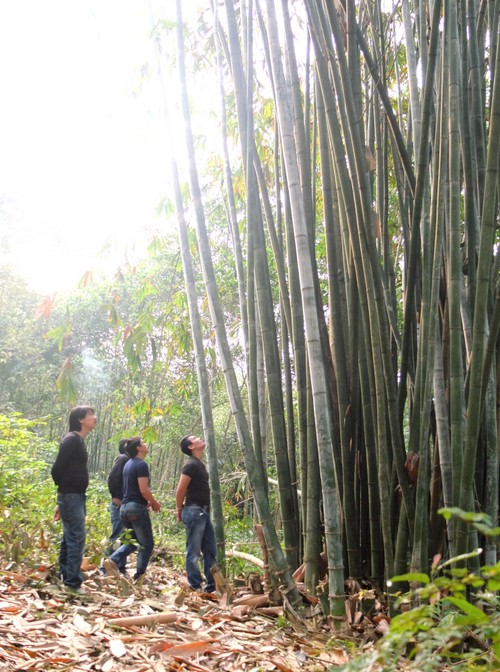 The group travels across Vietnam to find the best bamboo to make the "Dan Do". The group travels across Vietnam to find the best bamboo to make the "Dan Do". |
Cutting a bamboo tree needs three people: one at the base and two climbing 10 to 20 meters above to remove branches. Minh and his partners took a while to find the right bamboo for the "Dan Do." The bamboo bark should be a moldy green, according to Minh.
“The bamboo used for crafting the ‘Dan Do’ are grown in the northern mountain province of Tuyen Quang. Locals often grow these particular bamboo trees because their shoots make exceptionally tasty dishes."
"The trees selected should be between 15-20 years old. We opt for those in the center of the bamboo bush since they typically grow first, making them older than the surrounding trees. When cutting the bamboo, the fibers should have a rich red color, similar to beetroot,” Minh explained.
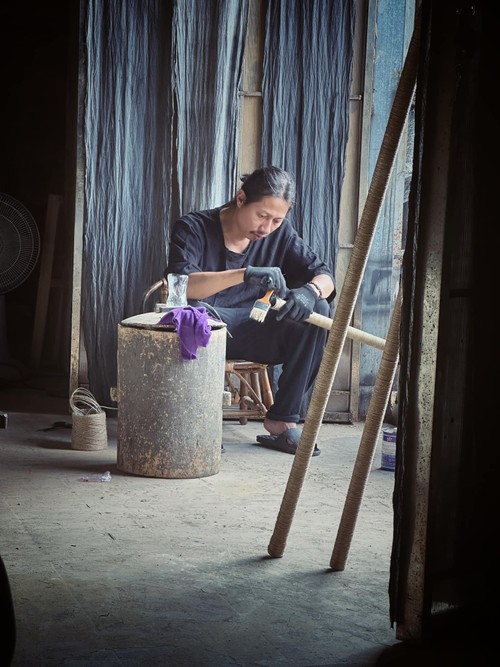 Nguyen Duc Minh is in the middle of making his original musical instrument. Nguyen Duc Minh is in the middle of making his original musical instrument. |
Each member of the group takes different roles during the creative process. Initially, half of them acted as creators, exploring like curious children. The other half became observers, extracting interesting elements from sound search games. The second role is that of a craftsman who needs to understand bamboo varieties and be very skilled and careful in chiseling.
Each member also needs to be a scientist who should persist in his work, understand principles of sound. He must have strong analytical skills for experimenting, and more importantly, not be afraid of making mistakes. But for Tuan, his most favorite role is that of an artist.
“The artist’s role is to transform ordinary things into aesthetic expressions and to convey emotional values – this is the core of art. Just by looking at a bamboo tree, can you imagine it making music one day? Creating this instrument requires an artist’s creativity with a love for their homeland, and this love should be shared,” Tuan said.
The group conducts all its research and experimentation at its headquarters, the "Dan Do" Lab, situated on the outskirts of an old factory area in Hanoi. The 200 square meter space mirrors the living space of people in Vietnam’s northern mountainous region, featuring clay floors and walls, bamboo ceilings, ceramic jars, and weaving machines.
The "Dan Do" Lab hosts monthly mini shows and workshops for up to 50 people. The artists sit almost cross-legged, balancing a thick bamboo tube on one ankle while gently placing their hands on a smoothed and seasoned wooden surface. The "Dan Do", with segments severed and shaped, produces different length tines that vibrate freely. When struck softly, they create shimmering notes, blending into coarser tones, weaving waves of harmony.
“In our mini concert ‘Do’s Story’ we share the background of each and every musical instrument we’ve crafted, linking it to its environment and the local geography of its origin. A low-pitched "Dan Do" sounds like a gong, and a high-pitched one echoes a bell. The interesting mix of these sounds creates an engaging experience,” said Minh.
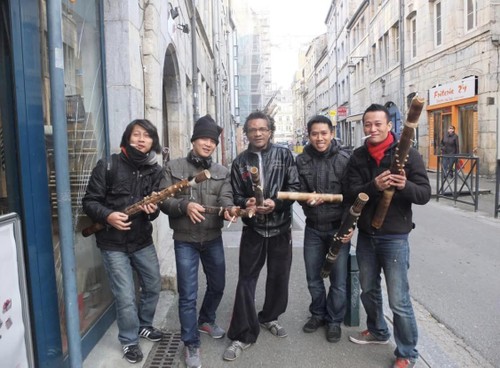 The group first met in 2008 in Paris. The group first met in 2008 in Paris. |
The "Dan Do" group first met in 2008 when Minh joined the cast preparing for the contemporary circus show “My Village” which was premiering in Paris. During this time, he met Tuan, Ngoc, and Su, and the four formed a close friendship over three years, performing shows in theaters and across cultural spaces in Europe.
After coming back to Hanoi, the they embarked on a new journey, delving deeper into their roots to explore elements and aesthetics passed down through indigenous music practitioners from various ethnicities. Visual artist Nguyen Duc Phuong became their fifth member with a very special role.
"My role is documenting the group’s activities and movements using painting techniques and manual sketching. This method, being made on paper creates a stronger connection than photos and videos,” said Phuong.
 Visual artist Nguyen Duc Phuong documents the group’s activities and movements in his paintings. Visual artist Nguyen Duc Phuong documents the group’s activities and movements in his paintings. |
Phuong has gathered over 1,000 samples of soil from different parts of the country, primarily focusing on the rich red clay extracted from the banks of the Red River. After months of exploration and experimentation, he used some samples in his paintings. Soil, for him, is not just a medium; it holds historical significance. He likens his research on soil to musicians exploring bamboo as a material. Phuong’s paintings bring a tenderness, an amiable affection to the "Dan Do" Lab. Phuong documented the group's early activities on Dzo or poonah paper.
"This painting illustrates members creatively working with the ‘Dan Do’, treating the instruments as pillows and forming a deep connection," Phuong said, adding the instruments offer comfort during sleep and nurture the artists' emotions. "They are loved like the artists’ own children. This unique bond is best depicted in paintings rather than photos or videos."
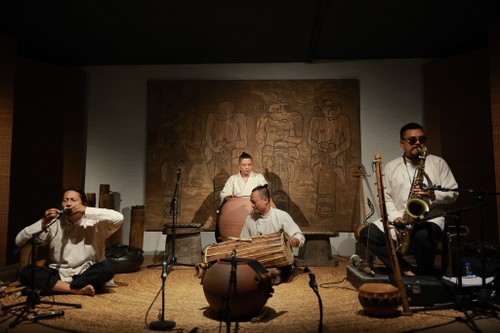 The "Dan Do" group collaborates with jazz artist Quyen Thien Dac (R) for a concert combining northwestern Vietnamese music and jazz. The "Dan Do" group collaborates with jazz artist Quyen Thien Dac (R) for a concert combining northwestern Vietnamese music and jazz. |
Aside from theater performances, "Dan Do" creates an interactive space for various music genres. Later this month, they will partner with Jazz artist Quyen Thien Dac for a music night called “Avant-Garde”, blending northwestern Vietnamese music with jazz.
“As a Vietnamese, I love to play jazz music in the Vietnamese style and language. My wish is to create a Vietnamese jazz genre, so, when "Dan Do" blends with jazz, it enhances the native jazz that I love. We’ll play music together spontaneously on stage, aiming for a music that resonates with everyone, allowing them to connect with our pieces and find themselves in the experience,” Dac elaborated.
For the "Dan Do" group, boosting indigenous music isn’t about achieving success; every step and stage is merely a bus stop. For Minh and Tuan, this is a lifelong commitment, something they’ll continue until their last breath.
“We share a passion and the same dream. As artists, we persist in doing what we love, even if it goes unrecognized by the general public,” said Tuan.
“As long as I’m breathing, the Dan Do will remain alive. I wish that when I’m gone, it would be wonderful if someone or a community continues to play it or recognize it as a Vietnamese instrument,” said Minh.
Photo and video courtesy of " Dan Do" group